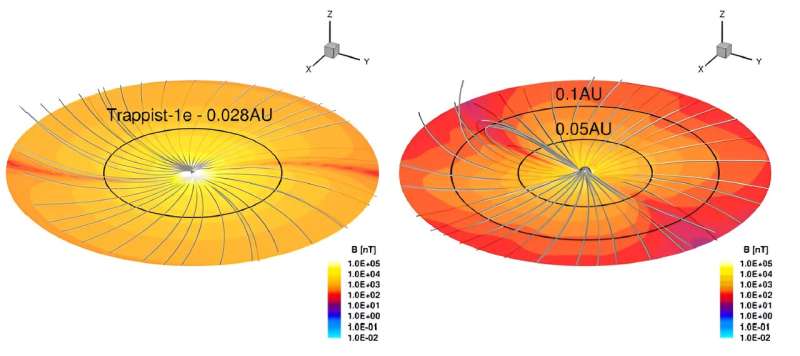February 21, 2024 feature
This article has been reviewed according to Science X's editorial process and policies. Editors have highlighted the following attributes while ensuring the content's credibility:
fact-checked
peer-reviewed publication
trusted source
proofread
Possible atmospheric destruction of a potentially habitable exoplanet

Astrophysicists studying a popular exoplanet in its star's habitable zone have found that electric currents in the planet's upper atmosphere could create sufficient heating to expand the atmosphere enough that it leaves the planet, likely leaving the planet uninhabitable.
Until now, planetary scientists have thought that a habitable planet needs a strong magnetic field surrounding it to act as a shield, directing ionized particles, X-rays and ultraviolet radiation in the stellar wind around and away from its atmosphere.
That's what happens on Earth, preventing dangerous radiation from reaching life on the surface, and what does not occur on Mars, which now lacks a global magnetic field, meaning any initial inhabitants of the red planet will probably need to live in underground caves and cavities for solar wind protection.
The new research, by Ofer Cohen of the Lowell Center for Space Science and Technology at the University of Massachusetts Lowell and colleagues, published in The Astrophysical Journal, examined whether electric currents generate in the ionosphere of the exoplanet Trappist-1e would lead to enough heating and expansion of the atmosphere that it might dissipate away from the planet's gravity and be lost to space.
TRAPPIST-1e is a cool M-dwarf star in the constellation Aquarius about 41 light-years from Earth. Its planetary system, which has seven observed exoplanets, is the most closely studied system outside our own solar system.
Three of these planets are in the star's habitable zone, with surface temperatures where liquid water could exist. Because M-dwarfs, which comprise about 70% of stars in the universe, are cooler than our sun, these zones are much closer to these stars.
Trappist-1e, an exoplanet discovered in 2017, orbits just 0.028 AU from its star (where 1 AU is the average distance from the sun to Earth; Mercury orbits at about 0.4 AU). Rocky and Earth-like, its average density is only 2% larger than Earth's, and its surface gravity 82%. What's more, it has a equilibrium temperature of 246 Kelvin, just 9 K below Earth's.
These properties make Trappist-1e one of the most interesting of all exoplanets discovered to date. But does it have an atmosphere? Because it is located much closer to its star, atmospheric stripping by stellar winds should be much stronger than, say, Mercury's, which has no atmosphere.
Earlier work showed that stellar winds from Trappist-1 could potentially strip a hydrogen-rich atmosphere from its exoplanets by photoevaporation, but modeling complexity means these planets could have a host of atmospheric environments.
But another potential stripping mechanism is when external charged stellar winds impact the ionized upper atmosphere. In earlier work Cohen and others found that when the conductance and impedance of each are similar in magnitude, the three Trappist exoplanets e, f and g, could experience direct current (DC) resistive heating of up to 1 watt per square-meter, 1% of the incoming solar irradiance and 5 to 15 times the stellar energy from extreme-ultraviolet radiation. Such "Joule heating" could potentially strip the atmosphere from any of these planets. (On Earth, Joule heating is about 0.01 W/m2.)
Now Cohen and colleagues have modeled a second phenomenon that could also impact Trappist-1 planetary atmospheres: heating due to the planet's motion itself. Alternating electric currents (AC) will be generated in the planet's upper atmosphere as it encounters a changing stellar magnetic field as the planet orbits its star (Faraday's law of induction).
Close-in planets orbit very quickly—Trappist-1e's orbital period is just 6.1 Earth-days—and the rapid change in the background magnetic field leads to the generation of strong ionospheric currents that dissipate and create potentially very high heating, which they call voltage-driven Joule heating.
Because astronomers do not have measurements of Trappist-1's stellar wind and magnetic field, the group used validated physics-based models to calculate its energy output, its solar wind and the changing magnetic field at the Trappist-1e distance. Using reasonable estimates for the width of Trappist 1e's ionosphere, its conductance and the magnitude of the changing magnetic field, their results show that the Joule heating energy flux in the upper atmosphere of the planet would vary from 0.01 to 100 W/m2, a significant amount of heating that may be greater than that due to extreme-ultraviolet and 1 to 10% of the stellar energy flux at the planet.
They conclude that such intense values could cause a strong atmospheric escape and "could lead to a rapid loss of the atmosphere." It means astrobiologists and others should take Joule heating into account when considering an exoplanet's habitability.
"It is likely that both mechanisms operate together in close-in exoplanets," said Cohen. "Therefore, our work (and our solar system knowledge) may suggest that exoplanets located very close to the star are likely bare planets with no atmosphere."
Cohen notes that their work has a political element, as many teams are investigating the atmospheres of Trappist-1 planets. The James Webb Space Telescope (JWST) has already started to observe this system's planetary atmospheres (finding none), and there are plans to do more. "This may be a bit of a waste of resources if there is no atmosphere to study," said Cohen.
More information: Ofer Cohen et al, Heating of the Atmospheres of Short-orbit Exoplanets by Their Rapid Orbital Motion through an Extreme Space Environment, The Astrophysical Journal (2024). DOI: 10.3847/1538-4357/ad206a
Journal information: Astrophysical Journal
© 2024 Science X Network





















